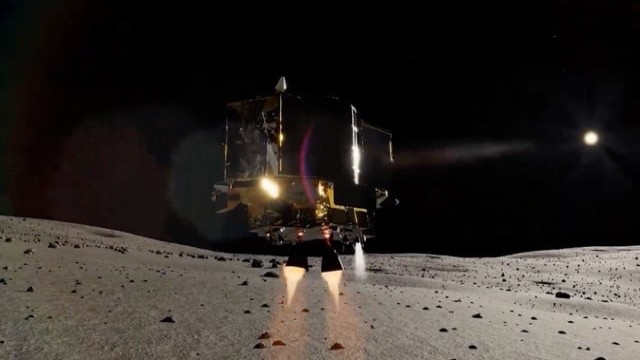Japan is the fifth country to land on the moon, after the US, the USSR, China, and India. Kuninaka, Japan's space program attained a "minimum" level of success
With a flawless soft landing on the lunar surface early on Saturday, one of Japan's unmanned spacecraft became the fifth nation in history to reach the moon.
Space officials asserted that additional time is needed to evaluate if the Smart Lander for Investigating Moon, or SLIM, succeeded in executing its primary mission objective of landing precisely. Additionally, they claimed that the solar panel on the vehicle had failed to produce power, which may have limited its time on the moon.
Space officials, according to Hitoshi Kuninaka, chairman of the Institute of Space and Astronautical Science, a division of Japan's space agency, think the small rovers of the SLIM were launched as intended and that data was being transmitted back to Earth.
However, he said that SLIM's solar battery was running out of juice and would only last a few more hours. He stated that gathering as much information as possible about the moon and the craft's landing on the remaining battery was now the top priority.
Japan is the fifth country to land on the moon, after the US, the USSR, China, and India.
According to Kuninaka, Japan's space program attained a "minimum" level of success.
At around 12:20 a.m. Tokyo time on Saturday (or 1520 GMT Friday), SLIM touched down on the moon.
The Japan Aerospace Exploration Agency's mission control first reported that SLIM was on the lunar surface but that it was still "checking its status," which led to a nervous wait for news.tus.” No further details were given until a news conference nearly two hours later.
In order to declare the mission a complete success, space experts must verify if SLIM landed precisely. Although more time is required, Kuninaka stated that, in his opinion, the goal was probably accomplished. This belief is supported by data he saw that demonstrated the spacecraft's motion leading up to the landing and its capacity to send out signals following it.
SLIM is a light spacecraft roughly the size of a passenger car that was intended to strike a very small target. The technology used, known as "pinpoint landing," promises much more control than any previous moon mission.
SLIM's target was only 100 meters (330 feet) away, whereas the majority of earlier probes employed landing zones that were roughly 10 kilometers (six miles) broad.
According to Hiroshi Yamakawa, president of the Japan Aerospace Exploration Agency, or JAXA, a precision landing would be the first of its kind in history and would require critical technology for a long-term, accurate, and sustainable space probe system.
According to Yamakawa, Japan needs the technology to establish its position and participate in international space programs.
The project was the result of JAXA's twenty years of precise technological work.
SLIM, also known as "the Moon Sniper," began descending on Saturday at midnight and, according to JAXA, the space agency, reached a height of roughly 10 kilometers (six miles) above the lunar surface in just 15 minutes.
The lander was in a vertical fall mode at five kilometers (three miles) above the surface, and SLIM was meant to travel in a parallel fashion to find a safe landing location at fifty meters (165 feet) above the surface, according to JAXA.
According to JAXA, the spacecraft was testing technologies that would enable lunar landings "where we want to, rather than where it is easy to land." The spacecraft was also intended to investigate the moon's origins by examining minerals using a specialized camera.
The SLIM was intended to land close to the Shioli crater, which is close to an area covered in volcanic rock. It was outfitted with pads on each of its five legs to cushion impact.
Only ten days had passed since a closely watched American private company's moon mission failed due to a fuel leak that occurred hours after launch.
In September, SLIM was launched aboard a Mitsubishi Heavy H2A rocket. On December 25, it left Earth's orbit and moved into the lunar one.
Japan wants to restore trust in its space technologies following several setbacks. An attempt was made in April to land a spacecraft built by a Japanese business on the moon, but the launch of the company's new flagship rocket in March was unsuccessful.
JAXA has a history of making challenging landings. Launched in 2014, its Hayabusa2 spacecraft made two landings on the 900-meter (3,000-foot)-long asteroid Ryugu, gathering samples that were brought back to Earth.
Particularly on the moon, a successful precision landing by SLIM would boost Japan's standing in the international space technology competition.
Aeronautics professor Takeshi Tsuchiya of the University of Tokyo's Graduate School of Engineering stated that it was critical to verify the precision of landing on a desired location.
"To be able to properly assert Japan's position in lunar development, it is necessary to show the world that Japan has the appropriate technology," he declared. According to him, the moon is significant for resource exploitation and can serve as a launchpad for trips to other planets, such as Mars.
Lunar excursion vehicles LEV-1 and LEV-2, which were carried by SLIM and are thought to have been released shortly before landing, are two tiny autonomous probes.
Recording SLIM's landing is the responsibility of LEV-1, which is fitted with a camera and an antenna. JAXA, in partnership with Sony, Tomy, and Doshisha University, created LEV-2, a ball-shaped rover outfitted with two cameras.
End//voice7news.tv






























Comment: